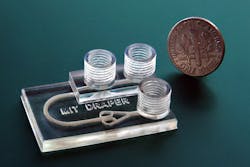Experimenting with Cancer Treatments Outside the Human Body
One of the obstacles researchers face in developing effective cancer treatments is the need to test them on live tumor tissues. Many patients undergo multiple drug trials to find a treatment that works. While artificial tumors can be grown to test drugs on specific cancer types, these take weeks to grow and do not account for an individual patient’s biological makeup. But new research from MIT has resulted in a microfluidic device, the tumor analysis platform (TAP), that can simulate different cancer treatments on biopsied tumor tissue.
The TAP device can be 3D printed within one hour and is slightly larger than a quarter. Three cylindrical shafts rise from the surface of the device and serve as ports to input and drain fluids, as well as remove air bubbles. Fluid—including various media, fluorescent markers, or lymphocytes—gets injected into an inlet port adjacent to the trap. The fluid enters through the inlet port and flows past the trap.
Here, any bubbles that are in the fluid rise up through the threaded port. Bubbles can disrupt the experiment or release air that destroy the tumor tissue, which is why it is necessary to remove them from the fluid. The fluid is then routed around a small U-turn into the tumor’s chamber, where it flows through and around the tumor fragment.
The tumor-trapping chamber sits at the intersection of the larger inlet channel and four smaller outlet channels. Tumor fragments are less than 1 millimeter across and are injected into the inlet channel via the bubble trap, which helps remove bubbles introduced when loading. The tumor is guided downstream to the tumor trap as fluid flows through the device from the inlet port. This is where the fragments get caught and the fluid continues traveling along the outlet channels (which are too small for the tumor to fit inside) and drains out of the device.
A continuous flow of fluids keeps the tumor fragment in place and constantly replenishes nutrients for the cells. Clinicians can examine the device under various imaging techniques to examine the tumor and, in the future, monitor different drug treatments as they are applied to the tumor fragments.
MIT researchers have 3D printed a novel microfluidic device that simulates cancer treatments on biopsied tumor tissue—and keeps the tissue alive for days—so clinicians can better examine how individual patients will respond to different therapeutics. (Courtesy: MIT researchers)
Key to keeping the tissue alive on the TAP device is the use of a resin typically used for dental applications. The resin is Pro3dure GR-10, primarily used to make mouthguards that protect against teeth grinding. This material is nearly as transparent as glass, with very few surface defects, and can be printed in very high resolution.
The team tested the resin to a 96-hour cytotoxicity test, an assay that exposes cells to the printed material and measures how toxic that material is to the cells. The cells were still alive after the 96 hours. The biocompatible resin kept 90% of the biopsied tumor tissue alive for at least 72 hours. This ability, combined with the ease and affordability of device fabrication, makes it perfect for clinical settings.
Immunotherapy research is one application that could benefit from this device. Immunotherapy treatment for cancer helps the patient’s own immune system to fight the tumors. For example, this year’s Nobel Prize recipients in physiology developed an immunotherapy drug that blocked specific proteins in white blood cells, which would typically prevent those cells from attacking cancer cells.
“People anywhere in the world could print our design,” says Luis Fernando Velásquez-García, a researcher for Microsystems Technology Laboratories. “You can envision a future where your doctor will have a 3D printer and can print out the devices as needed.” Velásquez-García is co-author of a paper describing the device which appears in the December issue of the Journal of Microelectromechanical Systems.
The first round of testing showed that a tumor fragment could be kept alive and monitoring of the tissue viability in real-time with fluorescent markers. The next stage is to test how the tumor fragments respond to real therapeutics.


